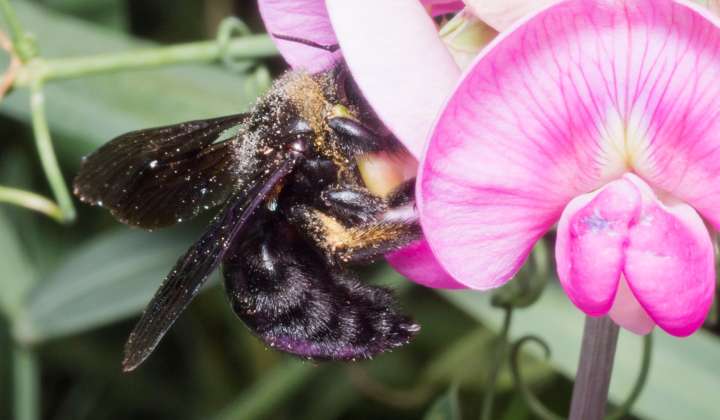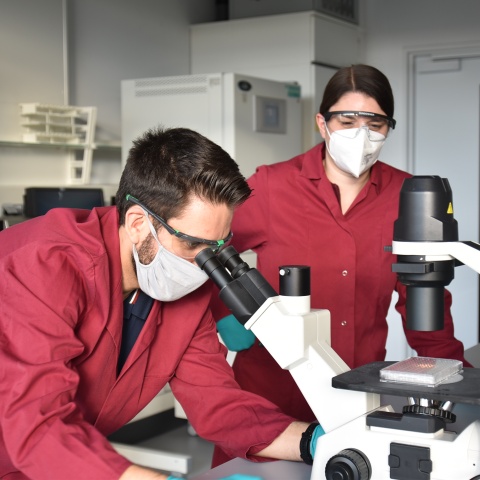A fire brigade against dangerous mosquitoes
Technological innovation from Hesse can protect against the spread of tropical diseases
The warm season in Europe marks the beginning of the high season for mosquitoes. While they and their larvae serve as prey for many animals and thus play an important role in the ecosystem, humans find the small bloodsuckers rather annoying. Meanwhile, they can also become dangerous to us: mosquitoes from tropical and Asian regions are increasingly appearing in Central Europe. They can transmit the Zika or West Nile viruses, which trigger dangerous fever diseases. A team of scientists from the Hessian LOEWE Centre for Translational Biodiversity Genomics and partner institutions is showing how the further spread of these mosquito species can be prevented in a targeted and environmentally friendly way.
Of the approximately 3,500 species of mosquitoes worldwide, around 100 are native to Europe. But there are more and more: favoured by global trade and climate change, invasive species such as the Asian tiger mosquito, the Japanese bush mosquito or the yellow fever mosquito are increasingly settling here. They bring with them the ability to transmit viruses of originally tropical diseases: while the West Nile virus has already established itself in Germany, dengue and yellow fever infections are also spreading northwards from the Mediterranean region.
However, the control of invasive mosquitoes, whose larvae develop in water, is not only a great challenge technologically, but also in terms of socio-political aspects. This is because innovations in laws and regulations in the course of the German government’s “Insect Protection Action Programme” restrict the use of pesticides, especially in and around water bodies. The release of genetically modified mosquitoes is rejected by the majority of the population. But what is the best way to protect human health?
In an article published in the journal “Biotechnology Advances”, a consortium of researchers from Frankfurt and Giessen at the LOEWE Centre TBG shows a way out of this dilemma between nature and health protection with a new technology they have developed. Their common goal is to build a kind of fire brigade against tropical diseases transmitted by mosquitoes.
Efficient monitoring of the spread of mosquitoes and viruses is initially made possible by the genetic analysis of water samples, so-called “environmental DNA”. For this purpose, the team has already sequenced the genomes of various immigrant mosquitoes to develop procedures that enable reliable detection similar to a PCR test. In a second step, the new technology of “RNA interference” is used. “In this process, the mosquito larvae in the distribution area are provided with food that contains double-stranded ribonucleic acids, or RNAs for short. These important information and function carriers, which are found in every cell of living organisms, then unfold their effect via the larvae’s intestine and switch off some of their genes that are important for survival,” explains Miklós Bálint, Professor of Functional Environmental Genomics at the Justus Liebig University Giessen, the LOEWE Centre TBG and the Senckenberg Biodiversity and Climate Research Centre Frankfurt, one of the first authors of the study. The advantages of this method: “The RNA molecules can be produced in such a way that they only act against the respective mosquito species and do not endanger other insect species or humans. Furthermore, no toxic residues are left in the environment during their degradation. And with this method, there will be no genetically modified mosquitoes capable of reproducing,” Bálint says.
Currently, teams in the consortium are researching the development of double-stranded RNAs that are particularly well suited for mosquito control and virus control. Another major challenge is their “packaging”. “A suitable formulation for this must not disintegrate too quickly in the environment, but should be absorbed in the form of particles by mosquitoes living in the water,” reports Prof. Andreas Vilcinskas, head of the Bioresources section at the Fraunhofer Institute for Molecular Biology and Applied Ecology IME in Giessen, where a solution is being worked on.
Vilcinskas is coordinating the establishment of the “fire brigade” to combat invasive mosquitoes at the LOEWE Centre TBG and the partner institutions involved, such as Goethe University Frankfurt am Main, Justus Liebig University Giessen, the Senckenberg Society for Nature Research, the Institute for Social-Ecological Research (ISOE) in Frankfurt and the Institute of Tropical Medicine in Antwerp, Belgium. “Our publication shows how RNA interference, or RNAi for short, can be developed to market maturity in Europe as an innovative and environmentally friendly technology for controlling so-called vectors – pathogen-transmitting organisms. Sprays based on RNAi are also being developed against insect pests such as the Colorado potato beetle and should soon be on the market as an environmentally friendly alternative to conventional pesticides,” says Vilcinskas, describing the promising potential applications of the new method.
Publication in Biotechnology Advances:
Ruth Müller, Miklós Bálint, Kornelia Hardes, Henner Hollert, Sven Klimpel, Eileen Knorr, Judith Kochmann, Kwang-Zin Lee, Marion Mehring, Steffen U. Pauls, Greet Smets, Antje Steinbrink, Andreas Vilcinskas
“RNA interference to combat the Asian tiger mosquito in Europe: A pathway from design of an innovative vector control tool to its application”
https://doi.org/10.1016/j.biotechadv.2023.108167





